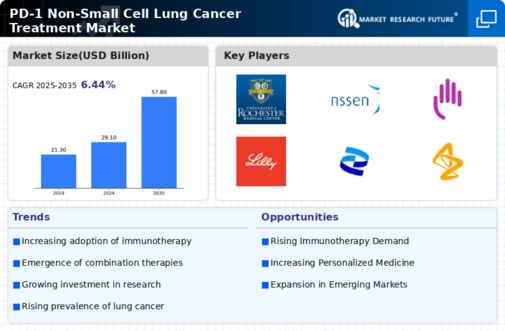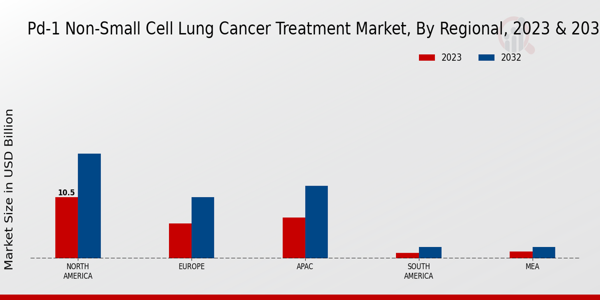Advancements in Immunotherapy
Recent advancements in immunotherapy have significantly influenced the Global PD-1 Non-Small Cell Lung Cancer Treatment Market Industry. PD-1 inhibitors, such as pembrolizumab and nivolumab, have demonstrated remarkable efficacy in treating NSCLC, leading to improved patient outcomes. These therapies work by enhancing the immune system's ability to recognize and attack cancer cells. Clinical trials have shown that patients receiving PD-1 inhibitors experience longer progression-free survival rates compared to traditional chemotherapy. As these therapies continue to evolve, the market is expected to expand, with projections indicating a growth to 57.8 USD Billion by 2035, driven by ongoing research and development.
Regulatory Approvals and Guidelines
The role of regulatory bodies in approving PD-1 inhibitors has been pivotal for the Global PD-1 Non-Small Cell Lung Cancer Treatment Market Industry. Regulatory approvals from agencies such as the U.S. Food and Drug Administration have facilitated the introduction of these therapies into clinical practice. Guidelines established by oncological societies further endorse the use of PD-1 inhibitors as standard treatment options for NSCLC. This regulatory support not only enhances physician confidence in prescribing these therapies but also encourages pharmaceutical companies to invest in further research. Consequently, the market is poised for growth, with a projected compound annual growth rate of 6.44% from 2025 to 2035.
Market Trends and Growth Projections
Growing Awareness and Patient Advocacy
The increasing awareness of lung cancer and the role of PD-1 inhibitors in treatment is driving the Global PD-1 Non-Small Cell Lung Cancer Treatment Market Industry. Patient advocacy groups are actively educating the public about lung cancer risks and treatment options, thereby encouraging early detection and treatment. This heightened awareness is leading to more patients seeking out PD-1 therapies, which are becoming recognized as viable treatment alternatives. As patients become more informed, the demand for these therapies is likely to rise, contributing to the market's growth trajectory. The combination of awareness and advocacy efforts is expected to play a crucial role in shaping the future of NSCLC treatment.
Increasing Investment in Cancer Research
The surge in investment for cancer research has a profound impact on the Global PD-1 Non-Small Cell Lung Cancer Treatment Market Industry. Governments and private organizations are allocating substantial funds towards the development of novel cancer therapies, including PD-1 inhibitors. This financial support is crucial for advancing clinical trials and bringing innovative treatments to market. For example, initiatives aimed at understanding the mechanisms of NSCLC and the role of the immune system in combating cancer are gaining momentum. As a result, the market is expected to benefit from these investments, leading to enhanced treatment options and improved patient outcomes.
Rising Incidence of Non-Small Cell Lung Cancer
The increasing prevalence of non-small cell lung cancer (NSCLC) globally is a primary driver for the Global PD-1 Non-Small Cell Lung Cancer Treatment Market Industry. As more individuals are diagnosed with this type of cancer, the demand for effective treatment options rises. For instance, the World Health Organization reports that lung cancer remains the leading cause of cancer-related deaths worldwide. This alarming statistic underscores the urgency for innovative therapies, including PD-1 inhibitors, which are gaining traction in clinical settings. The market is projected to reach 29.1 USD Billion in 2024, reflecting the growing need for advanced treatment modalities.










